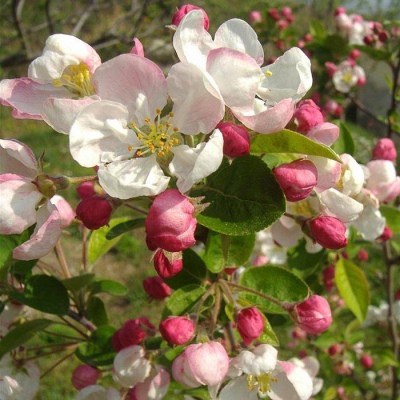
- Taste: tart, spicy
- Appointment: making jam
- Name synonyms: Malus Evereste, Paradise
- Decorative: Yes
- Height: from 4 to 6 m
- Crown: wide pyramidal, openwork, up to 5 m in diameter
- Branches: fan-shaped, side branches spreading, slightly hanging down with age, dark gray bark
- Escapes: pubescent at the ends
- Flowers: white with pink veins along the edges of the petals, wrinkled and curved inward, up to 3-3.5 cm in diameter
- Growth type : medium-sized
Many apple trees are grown not only for fruit, but also for decorating plots. This is exactly what the Everest apple tree is like. It is appreciated precisely for its extraordinary appearance - but this does not mean, of course, that a deep acquaintance with the purely horticultural side of culture is not needed.
Description of the variety
This plant has 2 synonyms - the Paradise apple tree and the Malus Evereste. The height of the tree varies from 4 to 6 m. The crown is shaped like a wide pyramid. Other features are worth noting:
crown diameter up to 5 m;
shoots with edges at the ends;
ovoid leaves of the next type of dark green color with a matte sheen;
fan arrangement of branches;
spreading of side branches;
white flowers with pink veins with a cross section of up to 3-3.5 cm.
Features, pros and cons
The apple tree Everest can get sick with scab and powdery mildew. The danger is especially great with a strong thickening of the branches. But these problems do not allow ignoring the objective merits of culture:
excellent decorative parameters;
resistance to low temperatures;
the possibility of using it as a pollinator for other apple trees.
Ripening and fruiting
Everest apple tree blooms usually in May. You can wait for the fruit in early autumn. Important: these fruits will not fall off for a long time. You can count on the first collection pretty soon.
Yield
In terms of fruit abundance, this variety is far ahead of the vast majority of ornamental apple trees. Unfortunately, the exact figures are not given in the available sources. However, references to abundant coverage of all branches are encouraging.
Fruits and their taste
Everest apples are used primarily for making jam. It is very rare to apply them in any other way. The diameter of a single fruit is only 2-2.5 cm. They are also characterized by:
orange-red color, with a red and slightly noticeable blue stripe;
rounded, slightly flattened shape;
spicy taste with pronounced astringency.

Growing features
Everest's frost resistance is assessed ambiguously. There are 2 digits (–23 and –28 degrees). To grow such a crop, loam with moderate moisture and optimal nutritional content is required. It is very important that groundwater does not approach the surface. Light and open areas are preferred for the variety; light shading is tolerable, but nothing more.
The apple tree Everest can successfully avoid scab infestation. Planting is preferable in the spring, when the soil has already thawed.A seedling that has overwintered in a container must be watered intensively before planting. If you have to plant the apple tree in dense soil, and there is no other choice, gravel drainage is used.
A homogeneous (in proportion) combination is laid in the landing pit:
peat;
ordinary fertile soil;
sand.
It is very useful to add a mineral fertilizer to this mixture so that the roots germinate faster. It is also recommended to use a root-forming preparation. The planted apple tree is watered with 20-30 liters of water. Since the plant tolerates cold very firmly, there is no special need for special insulation of the roots. The exception is cultivation in difficult climatic conditions.
Everest easily tolerates neighborhood with other green plants. Therefore, it can be planted without problems in the alleys and as part of landscape compositions. Culture thrives equally well in communities of all sizes. In the first year of development, the apple tree needs intensive watering, in the second year and then it is watered in the summer every 10 days, and in cool weather - as needed.
There are some more important tips:
mulch the trunk circle;
in the spring add mineral fertilizers to the soil;
feed Everest with organic matter in the fall;
despite the resistance to fungi, preventive treatments with Bordeaux liquid are useful.






The apple tree is a popular fruit crop among gardeners. It can be found in many summer cottages. But at the same time, such trees are often affected by various diseases. It is very important to recognize the disease in time and carry out the necessary procedures for a speedy recovery. Otherwise, the fruits will be spoiled, and the tree itself may die altogether.

Review overview
The decorative characteristics of this variety are quite attractive. It will be necessary to look after such a culture very carefully.But the appearance will be equally good, regardless of the season. It also blooms very gracefully.











































































